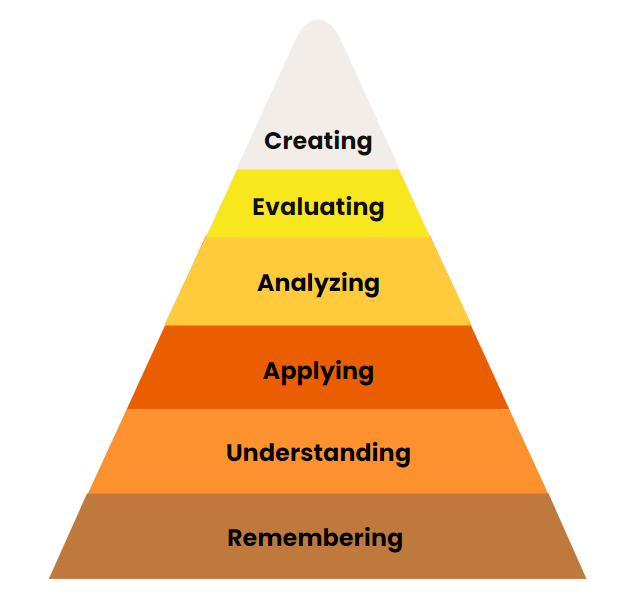Bloom’s taxonomy is a handy framework often used for setting educational goals. It divides learning processes into stages and ranks them from the easiest to the most difficult. This hierarchical structure helps students grasp sophisticated concepts step by step, which is why many study apps are built around the levels of thinking represented by Bloom’s taxonomy:
- Creating
- Evaluating
- Analyzing
- Applying
- Understanding
- Remembering

At Custom-Writing.org, we’ve selected 46 apps to help you reach each learning objective from Bloom’s taxonomy. All the apps are divided into categories that match each of the stages, starting with the high-level ones. There’s also a short description of each app along with a clickable name. All you need to do is find a taxonomy app that suits you best and start using it right away!
🦄 Bloom’s Taxonomy: Apps for Creating Things
- Animoto (video maker). Create and edit short video clips using your pictures, apply styles and themes, and add music.
- Desktop: +
- Android: +
- iOS: +
- Free version: +
- Canva (graphic design). Canva allows you to design and edit graphics and photos. You can add elements (stickers, text, frames, etc.) and work with templates.
- Desktop: +
- Android: +
- iOS: +
- Free version: +
- Animation Desk (animation). You can draw cartoons, create sketches, and create animations with this app.
- Desktop: +
- Android: +
- iOS: +
- Free version: +
- PodOmatic (podcasts). You can create, share, and listen to podcasts with the help of this app.
- Desktop: +
- Android: +
- iOS: +
- Free version: +
- Audio Memos (audio). This app allows you to record your voice, create memos, and share them with others.
- Desktop: +
- Android: +
- iOS: +
- Free version: +
- Celtx (scriptwriting, video production). You can create and organize various projects. Write video scripts, audio plays, stage plays, screenplays, and more.
- Desktop: +
- Android: +
- iOS: +
- Free version: –
- Google Drive (documents). Work on projects and documents in collaboration with other students. Leave comments and track changes.
- Desktop: +
- Android: +
- iOS: +
- Free version: –
- Co:Writer (texts). This app allows you to create written works and use topical dictionaries and word predictability.
- Desktop: +
- Android: –
- iOS: +
- Free version: +
- Soundation Studio (audio). You can create and edit songs with the help of this tool, import and export files, and publish your creations online.
- Desktop: +
- Android: –
- iOS: –
- Free version: +
- Puppet Pals (animation). This app allows you to create animated puppet shows in real time.
- Desktop: –
- Android: –
- iOS: +
- Free version: +
- Autodesk SketchBook (graphic design). This is a drawing app where you can create sketches and paintings. It has an engine that delivers natural-looking colors and textures.
- Desktop: +
- Android: +
- iOS: +
- Free version: +
- Adobe Spark Post (graphic design, videos). This tool will help you with creating imagery adjusted for any social media site. With ease.
- Desktop: +
- Android: +
- iOS: +
- Free version: +
2. ⚖️ Bloom’s Taxonomy: Apps for Evaluating Things
- Desmos (calculator). This graphing calculator helps build functions and shows the effects of certain coefficients on your graphs.
- Desktop: +
- Android: +
- iOS: +
- Free version: +
- GeoGebra (calculator). Apart from having a graphing calculator’s functions, this tool can also help to plot data, discover theorems, and apply algebra transformations.
- Desktop: +
- Android: +
- iOS: +
- Free version: +
- Padlet (documents & groups). An online board where you can cooperate, share files, and evaluate the tasks.
- Desktop: +
- Android: +
- iOS: +
- Free version: +
3. 📊 Bloom’s Taxonomy: Apps for Analyzing Things
- Wufoo (forms). This is a tool for building forms. It will enable you to collect, store, and analyze data.
- Desktop: +
- Android: –
- iOS: –
- Free version: +
- Google sheets (spreadsheets). It allows you to create spreadsheets and analyze data together with other members of the group.
- Desktop: +
- Android: +
- iOS: +
- Free version: +
- SimpleMind (mind maps). With this app’s help, you can create and synchronize mind maps and access them from any device.
- Desktop: +
- Android: +
- iOS: +
- Free version: –
- Airtable (organizer). An app that allows you to create databases, idea collections, and checklists. You can also manage the interactions between contacts.
- Desktop: +
- Android: +
- iOS: +
- Free version: +
- InstaGrok (concept maps). You can create, customize, and share interactive maps on certain topics. This tool will help you to research and analyze data more efficiently.
- Desktop: +
- Android: +
- iOS: +
- Free version: +
4. ⚒️ Bloom’s Taxonomy: Apps for Applying Things
- Google Docs (texts). This is a text processor that allows groups of people to work together on the same project in real time.
- Desktop: +
- Android: +
- iOS: +
- Free version: +
- PIXLR (images). A photo editor that allows you to apply changes to pictures you’ve made. From adjusting the colors to completely transforming the whole image.
- Desktop: +
- Android: +
- iOS: +
- Free version: +
- Google Earth (maps). A great app for applying and discovering new knowledge about our planet. It works well both for self-education and for working on specific projects.
- Desktop: +
- Android: +
- iOS: +
- Free version: +
- Explain Everything (whiteboard). This app provides students with a new way to share their knowledge and experience with other students.
- Desktop: +
- Android: +
- iOS: +
- Free version: +
- Haiku Deck (presentations). An app that provides you with an easy way to make presentations and slideshows on any topic.
- Desktop: +
- Android: –
- iOS: +
- Free version: +
- PicCollage (pictures). This app allows you to create collages with various backgrounds to choose from and with many editing options.
- Desktop: +
- Android: +
- iOS: +
- Free version: +
- Fractions (math). Allows students to work with fractions in the form of a circle, bar, or chart.
- Desktop: +
- Android: –
- iOS: +
- Free version: +
- ShowMe (tutorials). This app allows you to create tutorials with explanations recorded from the whiteboard and added voiceover chart.
- Desktop: –
- Android: –
- iOS: +
- Free version: +
- BeFunky (photo editor). A photo editor with a wide range of editing tools.
- Desktop: +
- Android: +
- iOS: +
- Free version: +
5. 🤔 Bloom’s Taxonomy: Apps for Understanding Things
- Annotate (screenshot annotations). An app that helps you to take screenshots and add various types of annotations to them. Then, the image can be shared through social media or via email.
- Desktop: –
- Android: –
- iOS: +
- Free version: +
- VoiceThread (voice messages). This cloud-based app helps to create, share, and comment on content. It’s also possible to integrate this app into a Learning Management System for better results.
- Desktop: +
- Android: +
- iOS: +
- Free version: +
- Nimbus Clipper (internet content). This app will help you to gather the information from the Internet by saving the whole pages or their fragments.
- Desktop: +
- Android: +
- iOS: +
- Free version: +
- Diigo (internet content). Diigo makes it possible to save entire web pages and synchronize everything you’ve saved across all your devices. It also has an annotations feature, readability mode, and PDF reader.
- Desktop: +
- Android: +
- iOS: +
- Free version: +
- Trello (collaboration tool). You can work on any task, list, or project with this app. It will present your work in the form of a storyboard with the steps you need to complete.
- Desktop: +
- Android: +
- iOS: +
- Free version: +
- Screencast-O-Matic (video). This app captures everything that happens on your screen and records your voice. You can then share this material for everyone else to see.
- Desktop: +
- Android: +
- iOS: +
- Free version: +
- QuizStar (quizzes). A tool that allows you to create a variety of free learning quizzes. It will help you to test the knowledge and understand each student’s strengths and weaknesses (or your own).
- Desktop: +
- Android: –
- iOS: –
- Free version: +
- Nearpod (interactive lessons). The app makes it possible to present information on individual screens, ask questions, and receive answers in real time.
- Desktop: +
- Android: +
- iOS: +
- Free version: +
6. 📝 Bloom’s Taxonomy: Apps for Remembering Things
- Quizlet (quizzes). This app helps to improve the preparation for tests or students’ performance in general. It helps to create flashcards, tests, and quizzes to help you digest new material and check your knowledge.
- Desktop: +
- Android: +
- iOS: +
- Free version: +
- Symbaloo EDU (documents). This app can act as storage for educational materials and resources. This kind of storage improves the accessibility of information and makes the collaboration smoother.
- Desktop: +
- Android: +
- iOS: +
- Free version: +
- Pocket (internet content storage). This app allows you to save any materials from the Internet in one place.
- Desktop: +
- Android: +
- iOS: +
- Free version: +
- Doodle (group scheduling). An app that helps you to schedule events and send invites. With this app, it won’t be any trouble to gather a group of people to discuss an important question.
- Desktop: +
- Android: +
- iOS: +
- Free version: +
- WolframAlpha (knowledge engine). This app uses special algorithms and methods to deliver knowledge and give answers to your questions. You can get exactly what you were looking for without having to blindly search for it on the web.
- Desktop: +
- Android: +
- iOS: +
- Free version: +
- MindMeister (mind maps). This is a tool that allows you to create mind maps. It will help you to make your ideas visual and share them with everyone.
- Desktop: +
- Android: +
- iOS: +
- Free version: +
- Evernote (notes). This app allows you to take notes and synchronize them across your devices. Great for keeping fresh ideas or capturing important information from the web or anywhere else.
- Desktop: +
- Android: +
- iOS: +
- Free version: +
- EdWordle (word clouds). This is a tool for creating so-called “word clouds”. If you use a piece of text, it will create it based on the most frequently used words. This tool will help you to highlight main ideas and thoughts.
- Desktop: +
- Android: –
- iOS: –
- Free version: +
- Popplet (idea organizer). This app allows you to gather and organize your ideas for more efficient use. Create connections between them, synchronize, and share the results of your work.
- Desktop: +
- Android: –
- iOS: +
- Free version: +
It won’t be a surprise if you’re already familiar with some of the apps listed in this chart. If a particular app is in a specific category, it doesn’t mean that you can’t use it to complete other tasks or for different purposes. It’s only a matter of your imagination and creativity. So feel free to experiment!
Did we miss something? Feel free to tell us about your favorite apps for studying in the comments.








![200 Powerful Words to Use Instead of “Good” [Infographic]](https://custom-writing.org/blog/wp-content/uploads/2020/12/portrait-fair-haired-beautiful-female-woman-with-broad-smile-284x153.jpg)



we इनर was very useful. Resource personal has good knowledge for it
Session was good and useful
Thank you for sharing this article. Really useful.